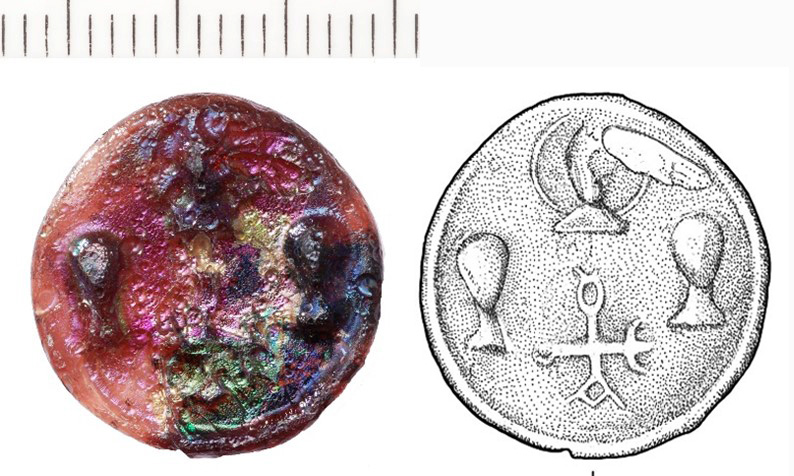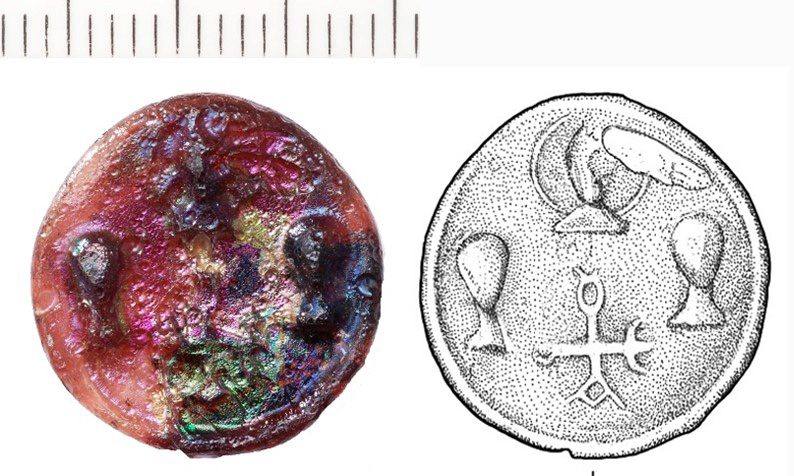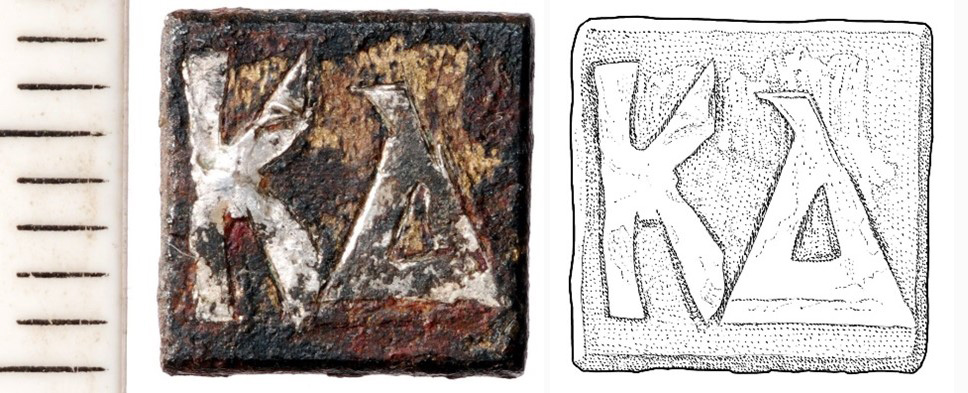
Sifting Project Discovers Byzantine Weights Suggesting Christian Activity on Temple Mount Before Islam
The Temple Mount Sifting Project announced this week their discovery of two unique Byzantine coin weights, both of rare four keration denomination (about 0.6 grams). The discovery reinforces the theory that there was significant t Christian activity on the Temple Mount before the Muslim conquest in the seventh century.
The first weight is made of purple glass and bears the impression of a known Imperial stamp. Researchers believe that it was probably manufactured in the Byzantine capital, Constantinople, and was brought to Jerusalem before the Muslim conquest in the seventh century. The glass weight was made by ladling out a small glob of molten glass onto a flat marble or metal surface and then impressing it in the center with a stamp. Its diameter is roughly 17 millimeters and is about 2 millimeters thick. It weighs 0.62 grams, which implies it corresponds to four keratia. The obverse side of the weight depicts an Imperial bust with a halo above a cross-shaped monogram flanked by two smaller busts. The monogram reads EVΘAΛIOV (‘of Euthalios’ in Greek).

Weights of this type have been described as ‘Imperial’ due to the impression depicting one or more imperial busts. The name Euthalius refers to a high-ranking Byzantine official under whose authority the weights were manufactured. These weights were likely produced in, and distributed from, a central official workshop in Constantinople, between 550–650 CE.
While approximately 20 other glass weights of this type and with this impression have been discovered, the recent discovery is the only one of a four-keration denomination. The other glass weights are either a nomisma (24 keratia), a semissis (12 keratia) or a tremissis (8 keratia).
The recently discovered four-keration weights would have been used to weigh gold tremissis coins cut in half or the rare half-tremissis coins. Four-keration weights are extremely rare, with only about four other examples known. No other weights with such a KΔ inscription are known to exist
The second weight is made of brass and is square. It measures 13.0 mm x 12.9 mm x 1.6 mm and weighs 0.60 g. The brass is composed of 78% copper and 22%. The weight bears a previously unknown silver inlay marking of the Greek letter Kappa Delta (ΚΔ) indicating that it is also of the four keration denomination as the letter Kappa designates it as the keration weight unit and the Delta signifies the number four. Such an investment of craftsmanship on such a tiny weight may suggest that it was part of a more extensive set of weights, and not simply an individual’s private item.

Square brass weights of this type were predominantly manufactured during the fifth and sixth centuries. The maintenance of official weights at the local level was set out in Byzantine law. It is possible, if not likely, that at least one of the Temple Mount weights discovered by the Sifting Project was one of these “official weights”.
To date, the Sifting Project has discovered about a dozen coin weights from the Byzantine era. The weights were used to measure the gold coins or coin fragments used in everyday transactions and tax payments carried out in the Temple. The principal gold coin of the Byzantine era was known as the solidus in the West and the nomisma in the East. This was a coin of very high purity (over 95%), first minted by Constantine the Great in 309 CE and weighing roughly 4.5 g. The weight of the nomisma was in turn divided into 24 sub-units called “keratia”.
Research on the discovery was conducted by Ph.D. candidate, Haim Shaham, who is an archaeologist and researcher in the Sifting Project. Details of the discovery were just made public in the latest volume (#18) of the Israel Numismatic Research journal in an article titled “Two Noteworthy Byzantine Weights from Jerusalem’s Temple Mount.” The article was authored by Haim Shaham, Zachi Devira, and Gabriel Barkay. Barkay and Devira are co-directors of the Temple Mount Sifting Project.
Researchers believe they were most likely used as official imperial weights that were required by 6th-century Byzantine law to be present in major churches. The sifting project has already recovered “many artifacts which can be assigned to the Byzantine era,” including items directly associated with churches, which “together with the recently discovered weights suggest that there might even have been a Byzantine church upon the Temple Mount,” the paper said.
Shaham, an expert on ancient coinage and an archaeology doctoral student at Bar-Ilan University, speculated that the wealth of findings from the Byzantine era suggests a significant Christian presence on the Temple Mount. The Sifting Project has also uncovered a large amount of elegant floor tiling from the era. The Sifting Project also discovered pieces of chancel screens, which is an element of early church architecture
“We have all this Byzantine material which shows that something was going on, but up until a decade ago, the consensus was that during the Byzantine period, the Temple Mount was desolate. But in actuality, a lot was going on during the Byzantine era, and from what we have found, it can be comfortably associated with a church.”
The discovery of the weights reinforces the theory that a church operated on the Temple Mount during the Byzantine era. Similar weights were found in another Byzantine church site, in Sussita in the Golan Heights. Muslim historical records emphasize that the Temple Mount was neglected and used for dumping trash before they constructed the Dome of the Rock in 682 CE.
“Based on that, historians have assumed the Temple Mount was a dump,” but that could be a case of history being written by the victors, Shaham said.
He proposed an alternative theory for the presence of the Byzantine material at the site suggesting that a Byzantine building on the Temple Mount had already been destroyed by the Sassanid Persian Empire that controlled Jerusalem in 614-630 CE.
The Sifting Project began in 1999 when the Northern Branch of the Islamic Movement conducted illegal renovations on the Temple Mount and disposed of over 9,000 tons of dirt mixed with invaluable archaeological artifacts. Though Israeli antiquities law requires a salvage excavation before construction at archaeological sites, this illegal bulldozing destroyed innumerable artifacts: veritable treasures that would have provided a rare glimpse of the region’s rich history. The earth and the artifacts within were dumped as garbage in the nearby Kidron Valley. In a bold move, archaeologists Dr. Gabriel Barkay and Zachi Dvira retrieved the matter from the dump, and in 2004, they started sifting it. Their initiative became the Temple Mount Sifting Project (TMSP) to rescue ancient artifacts and conduct research to enhance our understanding of the archeology and history of the Temple Mount. The Temple Mount Sifting Project’s finds constitute the first-ever archaeological data originating from below the Temple Mount’s surface.
In the past 15 years, through the help of some 200,000 paying volunteers, the project has recovered over 500,000 artifacts, including 5,000 coins, inscriptions, mountains of pottery, Egyptian-era cultic items, jewelry, and remnants of warfare.
The post Sifting Project Discovers Byzantine Weights Suggesting Christian Activity on Temple Mount Before Islam appeared first on Israel365 News.
Israel in the News